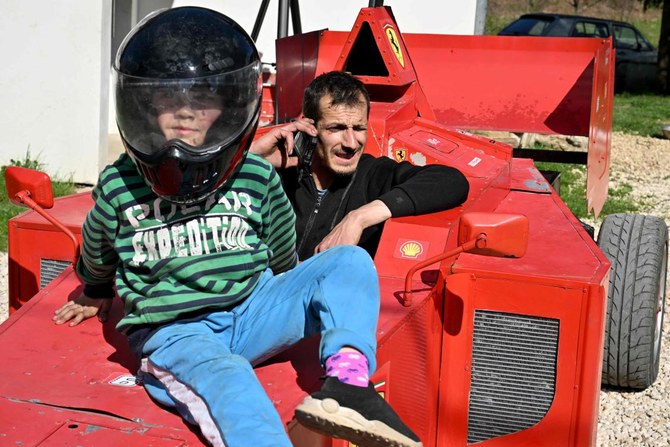LAGOS: Ada became a surrogate mother after her landlord threatened to evict her family from their apartment in Nigeria’s commercial capital, Lagos, two years ago.
But her husband wasn’t open to the idea when she first brought it up.
“He was like, ‘What’s that? Why on earth would you think of something like that? Please don’t even go there’,” she recalled.
Ada became intrigued about surrogacy when she heard about it on a US reality television show, but thought it was only for Westerners. Then a colleague revealed that she had done it.
But in a religiously conservative nation, many Christians and Muslims alike are skeptical of surrogacy — even though the practice has historic roots.
Some polygamous ethnic Igbo or Yoruba clans used surrogates when a wife was unable to conceive.
In some Igbo villages, certain women could “marry” another woman. Any child born from the marriage would take the name of the “female husband” and the male donor’s identity was never divulged.
But as years pass, traditions fade. In their place, a relatively lucrative but murky and secretive system has developed.
Ada, for example, was paid two million naira (more than $5,500, nearly 5,000 euros) to be a surrogate.
Key to her involvement was the surrogacy agency’s provision of decent accommodation for her, her husband and their own two children while she was pregnant.
“That was what attracted me to the project,” she told AFP.
“We had a pressing need to move out of our place and when I showed (my husband) the accommodation fee, he started looking at it differently, even though he was scared.”
Her husband’s fears were justified even if he finally relented: Nigeria is the fourth most dangerous country in the world to give birth.
According to the World Bank, 814 women die for every 100,000 births — four times more than the global average and 100 times more than in the European Union.
Ada eventually gave birth to twins. So as not to arouse suspicion and to avoid the stigma attached to surrogacy, Ada told her friends she lost the babies.
The taboo surrounding surrogacy is even greater for the women who have to turn to it.
Infertility is sometimes seen as divine punishment and most often the woman is blamed when couples are unable to conceive.
“When you go to church and you see couples praising God for giving them a child after 15 or 20 years, they say it’s a miracle but often it’s IVF (in-vitro fertilization) or surrogacy,” said a surrogacy agent, who gave his name as Chike.
“Most people in Nigeria can’t afford the cost of IVF or a surrogate mother, so there is not an extensive market for it in Nigeria.
“There are a lot of stereotypes around surrogacy because of the ‘baby factories’. People don’t know the difference.”
“Baby factories” are illegal maternity units where many young women and girls give birth anonymously after getting pregnant accidentally — sometimes as a result of rape — or go there to sell the newborn.
Huge social and religious pressure forces many infertile couples without means to go in desperation to these units, which are prevalent in southeast Nigeria and are often raided by police.
Toyin Lolu-Ogunmade knows the pain of not being able to have children but didn’t want to use a surrogate. “I wanted to carry a baby myself,” she said.
“My thinking was, ‘If you can’t carry a pregnancy, then how are you a woman?’ That is the essence of femininity and it’s being taken from me.”
“Most people want to have children that are from their own genes, adopted children are not biologically linked to you,” she explained, “with surrogacy, they are related.”
Lolu-Ogunmade’s 12-year struggle with infertility was due to uterine fibroids and post-surgery complications.
Doctors told her the only chance of becoming a mother was by using a surrogate.
“I didn’t know where to start,” she recalled.
After discussing the matter with her husband and their pastor, the couple traveled to India where surrogacy is legal.
They eventually returned to Nigeria in 2012 with twins and the idea of setting up an agency to help women with fertility problems.
In Nigeria, there are no laws governing surrogacy.
Lack of legislation leaves parents and the surrogate vulnerable to inadequate medical screening, a lack of psychological support and excessive use of Caesarean sections.
Ayo Sogunro, a human rights lawyer, said Nigerian courts were likely to follow common law precedents recognizing the rights of both parties in a surrogacy contract.
For Chike, the lack of proper legislation was too much of a risk and last month he closed his online agency after five years.
“We will not respond to any surrogacy requests. We thank you very much for your support,” a message reads on the firm’s Facebook page.
Chike said his involvement in commercial surrogacy has left him facing possible legal action for human trafficking — and it was not worth the risk.
“Nigeria is not ripe enough (for surrogacy) until there’s legislation in place,” he added.
Nigerian couples cautiously turn to surrogacy to ease fertility woes
Nigerian couples cautiously turn to surrogacy to ease fertility woes

- Infertility is sometimes seen as divine punishment and most often the woman is blamed when couples are unable to conceive
- “Most people in Nigeria can’t afford the cost of IVF or a surrogate mother, so there is not an extensive market for it in Nigeria
Used missiles for sale: Iranian weapons used against Israel are up for grabs on Jordan-based website
Used missiles for sale: Iranian weapons used against Israel are up for grabs on Jordan-based website

- Debris used in attack listed on OpenSooq online marketplace
LONDON: Fragments of missiles launched by Iran during the recent attack on Israel have been discovered for sale on Jordan’s prominent OpenSooq website, which is known for trading goods, including vehicles and real estate.
Al Arabiya reported on Sunday that the shrapnel was being advertised, with pieces described as “Used Iranian ballistic missile in good condition for sale,” and “One-time use ballistic missile for sale at an attractive price.”
The sellers had provided specifications and images of the missiles, describing them as “excellent type,” and mentioned their involvement in an “accident” resulting in “severe damage to the body.”
Some listings even included installment payment options.
Iran launched drones and missiles toward Israel late on Saturday as it retaliated following a suspected Israeli strike on the consulate annex building adjacent to the Iranian Embassy in Damascus, Syria, earlier this month.
While most projectiles were intercepted by a joint response from Israel, the US, UK, France, and Jordan, the attack marked Iran’s first direct military assault on Israeli territory, escalating tension and uncertainty in the region.
Following the attack, individuals shared photographs online showing debris that had fallen on Jordanian territory in areas such as Al-Hasa, Marj Al-Hamam, and Karak Governorate.
The Jordanian government confirmed that it had intercepted some flying objects in its airspace, with no reported damage or injuries.
Debris from such incidents often holds economic value. Metal debris from the Iraq War has been used by Iran-backed groups to finance their activities.
Similar items are sold online as military memorabilia, and there has been a surge in demand for such artifacts, as seen in Australia last year, preceding the country’s ban on the sale of hate symbols.
Google Doodle celebrates Lebanese-American poet and artist Etel Adnan

- Etel Adnan rose to fame for her 1977 novel Sitt Marie Rose about the Lebanese civil war
DUBAI: Google released its latest Doodle on Monday honoring Etel Adnan, a Lebanese-American poet, essayist and visual artist, considered one of the most accomplished Arab-American authors of her era.
The poet, who rose to fame for her 1977 novel Sitt Marie Rose about the Lebanese civil war, was born in Lebanon in 1925 to a Greek mother and a Syrian father, and grew up in multiple cultures, languages, nationalities and religions. Sitt Marie Rose won the France-Pays Arabes award and become a classic of war literature, so much so that it is taught in American classrooms.
In 1949, Adnan went to Paris to study philosophy at the Sorbonne before going to America to study at Harvard and Berkeley.
From 1958 to 1972, she taught philosophy in California, during which time she also started painting and writing poetry. She developed her literary voice in English and said abstract painting was the entry point into her native Arabic.
Adnan returned to Beirut, where from 1972 to 1976 she worked as the arts editor for two newspapers. She returned to California in 1979, then spent her later years living between Paris and Beirut.
In 2003, Adnan was named “arguably the most celebrated and accomplished Arab American author writing today” by the academic journal MELUS: Multi-Ethnic Literature of the United States.
Adnan’s most recent honor was in 2020. Her poetry collection “Time,” which is a selection of her work — translated from French by Sarah Riggs — won the Griffin Poetry Prize.
The King Abdulaziz Center for World Culture, or Ithra, earlier this year opened an eponymous exhibition in her honor – “Etel Adnan: Between East and West” – showcasing 41 of her works. The space at Ithra’s gallery is the first solo exhibition of Adnan’s work in Saudi Arabia, running until June 30.
The works on display span from the beginning of Adnan’s artistic career in the late 1950s through to her final creations in 2021, shortly before her death that year aged 96.
Some of the works are on loan from significant international institutions such as the Sharjah Art Foundation, Sfier-Semler Gallery and Sursock Museum. Some are part of private collections.
‘HELP’ written in palm fronds lands rescue for Pacific castaways

- The trio became stranded on Pikelot Atoll, a tiny island in the remote Western Pacific, after their motor-powered skiff malfunctioned
- A US Navy aircraft saw the "help" sign and a ship came later to rescue the stranded trio, all experienced mariners in their 40s
LOS ANGELES: Sometimes all you have to do is ask for “HELP“: That’s what three men stranded on a deserted Pacific island learned earlier this week, writing the message in palm fronds which were spotted by US rescuers.
The trio, all experienced mariners in their 40s, became stranded on a lonely island after setting off from Micronesia’s Polowat Atoll on March 31 in their motor-powered skiff which subsequently experienced damage.
They were reported missing last Saturday by a woman who told the US Coast Guard her three uncles never returned from Pikelot Atoll, a tiny island in the remote Western Pacific.
“In a remarkable testament to their will to be found, the mariners spelled out ‘HELP’ on the beach using palm leaves, a crucial factor in their discovery,” said search and rescue mission coordinator Lt. Chelsea Garcia.
She reported that the trio was discovered Sunday on Pikelot Atoll by a US Navy aircraft.
“This act of ingenuity was pivotal in guiding rescue efforts directly to their location,” she said.
The aircraft crew dropped survival packages, and rescuers one day later dropped a radio which the mariners used to communicate that they were in good health, had access to food and water, and that the motor on their 20-foot (six-meter) skiff was no longer working.
On Tuesday morning a ship rescued the trio and their equipment, returning them to Polowat Atoll, the Coast Guard said.
In August 2020, three Micronesian sailors also stranded on Pikelot were rescued after Australian and US warplanes spotted a giant “SOS” they had scrawled on the beach.
Dining hall with Trojan War decorations uncovered in ancient Roman city of Pompeii

- One fresco depicts Paris and Helen, whose love affair caused the Trojan War, according to classical accounts
- Pompeii and the surrounding countryside was submerged by volcanic ash when Mount Vesuvius exploded in AD 79
ROME: A black-walled dining hall with 2,000-year-old paintings inspired by the Trojan War has been discovered during excavations at the Roman city of Pompeii, authorities said on Thursday.
The size of the room — about 15 meters long and 6 meters wide — the quality of the frescoes and mosaics from the time of Emperor Augustus, and the choice of characters suggest it was used for banquets, Pompeii Archaeological Park said.

“The walls were painted black to prevent the smoke from the oil lamps being seen on the walls,” Gabriel Zuchtriegel, head of the park, said.
“People would meet to dine after sunset, and the flickering light of the lamps had the effect of making the images appear animated, especially after a few glasses of good Campanian wine.”
Pompeii and the surrounding countryside was submerged by volcanic ash when Mount Vesuvius exploded in AD 79, killing thousands of Romans who had no idea they were living beneath one of Europe’s biggest volcanoes.
The site has seen a burst of archaeological activity aimed at halting years of decay and neglect, largely thanks to a 105-million-euro ($112 million) European Union-funded project.

The dominant theme of the newly discovered paintings is heroism and fate.
One fresco depicts Paris and Helen, whose love affair caused the Trojan War, according to classical accounts. Another one shows doomed prophetess Cassandra and the Greco-Roman god Apollo.
According to Greek mythology, Cassandra predicted the Trojan War after receiving the gift of foresight from Apollo, but no-one believed her. This was because of a curse Apollo put upon her for refusing to give herself to him.
Bosnian Formula One fan brings speed dreams to the mountains

- The 36-year-old mechanic bought the car from another racing superfan in the capital Sarajevo last year
- Since purchasing the vehicle, he has been methodically making tweaks to its exterior, while nursing hopes of one day replacing its engine
KLJUC, Bosnia and Herzegovina: Far from the glitzy racetracks where legendary drivers made their mark in the world of Formula One, Himzo Beganovic has turned his dreams of speed into reality along the dirt roads of northwestern Bosnia.
“I always wanted to own a Formula One car, to have it in front of the house, to be able to go for a spin,” Beganovic told AFP, as he tuned up a replica “Ferrari red” race car outside his home near the Bosnian town of Kljuc.
The 36-year-old mechanic bought the car from another racing superfan in the capital Sarajevo last year.
The replica, which took two years to build, remains a ramshackle mock-up, crafted with sheet metal — a far cry from the advanced carbon fiber used in the multimillion-dollar cars of Formula One teams.
Despite Beganovic’s limited means, he still hopes to make his car more efficient, bit by bit.
Since purchasing the vehicle, he has been methodically making tweaks to its exterior, while nursing hopes of one day replacing its engine.
Along with a more powerful motor, Beganovic hopes to install an automatic gearbox and better tires.
“When you drive Formula One, you feel like you are flying. It is not like a car,” he said.
“It is the only one in Bosnia-Herzegovina. There are no others.”
A self-professed lover of “fast driving” and taking “dangerous turns,” Beganovic has been turning heads along Bosnia’s mountain roads where he reaches speeds of up to 200 kilometers per hour (124 miles per hour).
Other times he simply parks the car in a popular area and lets people check it out.
“I sometimes put it on a trailer to take it to other places in the country. People come, photograph it, and ask questions,” he said.
“The feeling is indescribable.”
For Beganovic, there was no question of what color the car would be.
As a longtime fan of seven-time world champion Michael Schumacher, the Ferrari-red paint pays tribute to the driver who won five titles with the famous Italian team.
Since the legendary German champion’s skiing accident in 2013 in the French Alps, Beganovic said he has yet to find another driver that interests him as much.
With Schumacher in mind, he hopes to put an Audi V-8 engine into his car soon.
“When a German engine and Bosnian ingenuity combine, you get an Italian car,” laughed one of Beganovic’s neighbors.





















